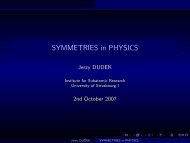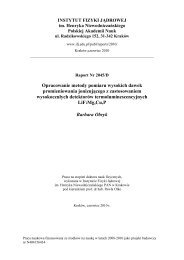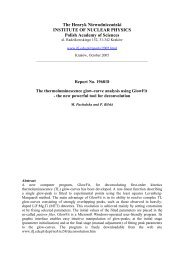Report No xxxx - Instytut Fizyki JÄ drowej PAN
Report No xxxx - Instytut Fizyki JÄ drowej PAN
Report No xxxx - Instytut Fizyki JÄ drowej PAN
You also want an ePaper? Increase the reach of your titles
YUMPU automatically turns print PDFs into web optimized ePapers that Google loves.
PHASE TRANSITIONS AND REORIENTATIONAL MOTIONS OF THE<br />
COMPLEX CATIONS AND NH 3 LIGANDS IN POLYCRYSTALLINES<br />
[Co(NH 3 ) 6 ](ClO 4 ) 3 AND [Zn(NH 3 ) 4 ](BF 4 ) 2<br />
Natalia Górska a , Łukasz Hetmańczyk a , Edward Mikuli a , Anna Migdał-Mikuli a , Krystyna<br />
Hołderna-Natkaniec b , Weronika Kasperkowiak b<br />
a Jagiellonian University, Faculty of Chemistry, Department of Chemical Physics,<br />
30-060 Kraków, ul. Ingardena 3, Poland; b A. Mickiewicz University, Institute of Physics,<br />
61-606 Poznań, ul. Umultowska 85, Poland<br />
Hexaaminecobal(III) chlorate(VII) and tetraaminezinck(II) tetrafluoroborate<br />
compounds (chemical formula: [Co(NH 3 ) 6 ](ClO 4 ) 3 and ([Zn(NH 3 ) 4 ](BF 4 ) 2 ), respectively) are<br />
particularly interesting molecular materials because of different reorientational motions of the<br />
complex cation and NH 3 ligands. In [Co(NH 3 ) 6 ] 2+ cation the Co 3+ ion occupies the center of<br />
an octahedron, while in [Zn(NH 3 ) 4 ] 2+ the Zn 2+ ion occupies the center of a tetrahedron of the<br />
NH 3 ligands. The ClO - 4 and BF - 4 anions have a tetrahedral structure and also perform fast<br />
reorientational motions. Both substances undergo a several solid-solid phase transitions which<br />
are attributed to the changes in the molecular groups arrangements as well as in their<br />
reorientational dynamics. The DSC measurements [1,2] performed in the temperature range<br />
90-300 K detected the phase transitions which thermodynamic parameters are presented in<br />
Table. 1.<br />
Table. 1. Thermodynamics parameters of the phase transitions on heating<br />
Compound T C [K] ∆H [J·mol -1 ]<br />
-1<br />
∆S [J·mol<br />
-1·K<br />
[Co(NH 3 ) 6 ](ClO 4 ) 3 103.2 137 1.4<br />
[Zn(NH 3 ) 4 ](BF 4 ) 2 179.4<br />
120.6<br />
106.5<br />
1370<br />
930<br />
80<br />
7.6<br />
7.7<br />
0.7<br />
1<br />
The proton magnetic resonance H NMR measurements were performed on a labmade<br />
spectrometer operating in the double modulation system at 25 MHz [3]. Fig. 1a and 1b<br />
show the temperature dependencies of the slope line width (δH) and the second moment (M 2)<br />
of NMR line in the studied compounds. In order to propose a model of internal dynamics, the<br />
second moment value was calculated from the van Vleck formula [4]. The onset of the<br />
following reorientations was taken into account during the heating of these compounds: the<br />
reorientation of NH 3 ligands about the M-N axis and the reorientation of octahedral or<br />
tetr ahedral cation, respectively. It was assumed that the N-H bond distances were of 1.00 Å<br />
and all the N-H bonds were tetrahedraly directed with respect to the Zn-N bonds, or<br />
octahedrally directed with respect to the Co-N bonds, and the distance Zn-N and Co-N takes<br />
the value of 2.01 and 2.28 Å, respectively. The M Rigid 2 obtained the value of 47.3 and 43.8 G 2 ,<br />
for [Zn(NH 3 ) 4 ](BF 4 ) 2 and [Co(NH 3 ) 6 ](ClO 4 ) 3 , respectively. The observed value of the second<br />
moment of 1 H NMR line for [Zn(NH 3 ) 4 ](BF 4 ) 2 close to 15 G 2 at 90 K can be interpreted as<br />
resulting from the NH 3 ligands reorientation. On heating at T C1 also the reorientations of<br />
tetrahedral [Zn(NH 3 ) 4 ] 2+ cation set on. The observed value of the second moment of 1 H NMR<br />
line for [Co(NH 3 ) 6 ](ClO 4 ) 3 close to 17 G 2 at 90 K can be interpreted also as resulting from the<br />
NH 3 ligands reorientation. On heating the reorientations of octahedral [Co(NH 3 ) 6 ] 3+ cation set<br />
on, too.<br />
108

















